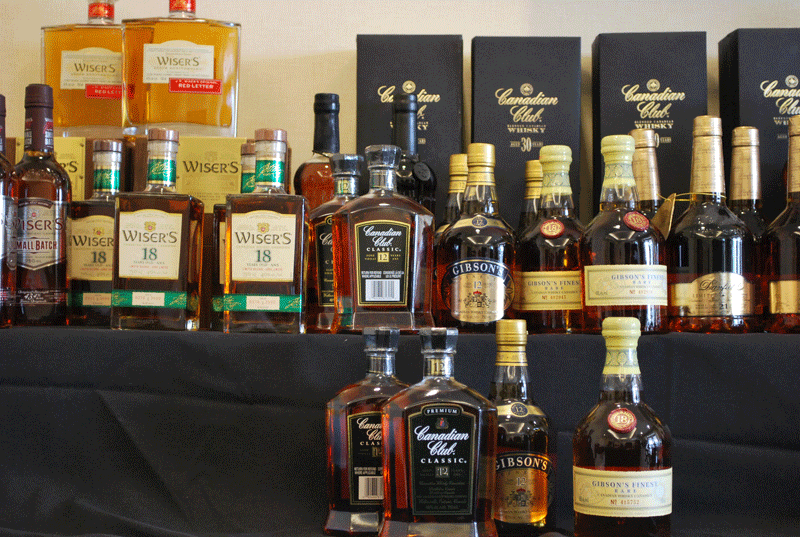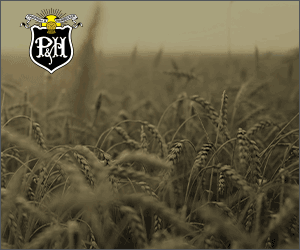A well-made whisky
THE CANADIAN WHISKY INDUSTRY THRIVES ON ONTARIO CORN
despite its long history and worldwide respect, the grain that goes into Canadian whisky is not often the topic of conversation. Any talk of corn usage is typically dominated by feed and ethanol, but there is no denying that Ontario corn has gained global admiration in the form of a well-loved golden-hued beverage.
“Our whisky is primarily made with Canadian corn and most of that corn is from Ontario,” says Jan Westcott, President and CEO of Spirits Canada which represents Canada’s distilleries.
There are three major distillers in Ontario; Hiram Walker in Windsor represents the largest distillery in North America, Canadian Mist in Collingwood which produces for export only and Kittling Ridge in the Niagara region which produces Forty Creek.
Ontario distilleries produce a wide range of whiskies including iconic brands like Canadian Club, Wiser’s, Gibson’s and Crown Royal. Our province is also home to Canadian Mist, Seagram’s VO, Royal Reserve, Forty Creek, and McGuinness Silk Tassel along with others produced for export only.
According to Westcott, Ontario distilleries use 110,000 to 120,000 tonnes of corn every year and they source almost 100 percent of that from right here at home. Although Canadian whisky is often referred to as ‘rye whisky,’ it is primarily made of corn.
“Typically, two types of whiskies are made in the distilling process,” explains Westcott. “A base whisky made from corn and a rye whisky. The rye whisky is very strong – you wouldn’t necessarily want to drink it on its own, but it is used to flavour the corn whisky.”

now and then
Canadian distillers have been turning Canadian corn into Canadian whisky for more than 200 years. Today, this whisky represents a $500 million export market and our whisky outsells all other types in the US, including Bourbon, Scotch and Irish whisky.
Originally, Canadian Club whisky was sold simply as “Club whisky” in American private gentlemen’s clubs in the 1880s. Bourbon whisky suppliers were upset with the success of this whisky and petitioned the US government to force Hiram Walker to put “Canadian” on the label in hopes of deterring sales, thus, Canadian Club was born. “Unfortunately for bourbon distillers,” relays Westcott, “the new name only served to make the drink more popular.”
quality grain
“Distillers are primary manufacturers,” explains Westcott. “They take the grain right from the field and turn it into a final product.”
The corn used is mashed, mixed with water and heated. Cooking the ‘mash,’ as it’s known in the distilling business, exposes the starch which can then be converted into simple sugars. After heating, the mash is cooled and yeast is added. The yeast consumes the sugar and leaves the alcohol. The liquid is drawn off the mash and it moves to the next stage of the distilling process.
The by-product of this process is distillers’ grain and just like in ethanol production, this grain is dried and sold back to farmers as livestock feed.
The liquid drawn from the mash is then distilled. The resulting distillate is aged in small wooden barrels for anywhere between five and 30 years. “Although legally you only have to age whisky for three years, most Canadian distillers age it for a minimum of five to get the desired flavour,” explains Westcott.
This whole process, points out Westcott, starts with quality grain. “I have had more than one master distiller tell me that ‘If you don’t have good grain, you don’t have good whisky.” To this end, Ontario distilleries buy high quality, food grade corn for their products because, unlike other types of liquor such as vodka, you want to be able to taste the grain.
challenges opening new markets
While Canadian whisky has saturated the North American marketplace, local distilleries are looking further abroad for future opportunities.
“We are currently looking at China, India and Colombia as possible future markets,” says Westcott. “These countries are just developing a spirits drinking middle class and there is a lot of opportunity there.”
As more exports means more corn, an expanding whisky market would benefit Ontario corn producers through increases in local demand. However, the distilleries face a lot of challenges in their effort to open overseas markets.
“These are expensive markets to open up,” says Westcott. “They are far away and the culture is very different.” The difference in culture means that the distilleries must adapt to a new way of doing business and new advertising strategies.
maximizing margins
Another big part of the issue, claims Westcott, is the margin available to the industry in Canada. In Canada, spirits are more heavily taxed than wine or beer, leaving less revenue for market development.
When you buy a drink at the bar, ordering spirits will cost you 20 cents in excise duties, while beer will set you back 10.5 cents, imported wine nine cents and Canadian wine is tax free. Despite the difference in taxes, all these drinks contain the same amount of alcohol. This discrepancy, claims Westcott, is making it difficult for Canadian distilleries to open doors to export markets because their margins are so small. The excise duties leave an 18 cents per dollar margin for the spirits industry. In comparison, beer takes a 50 cents per dollar margin and Canadian wine 85 cents per dollar.
Currently, Spirits Canada is working hard to get the tax rules changed. “We are petitioning the federal government for a modest reduction in excise duties on spirits, amounting to two cents per drink,” says Westcott. This would bring the tax per drink down to 18 cents from 20 and increase the margin per dollar of sales to 20 from 18 percent.
“We see a huge opportunity to dramatically expand our export business to markets in China, India, Colombia and Vietnam. But, you have to have the money in your jeans to make that happen,” concludes Westcott.
Despite these challenges, there is no doubt that Ontario’s corn-based whisky has enchanted North Americans for the past century and hopefully it will soon provide the same enjoyment for South-East Asians and South Americans for centuries to come. •








